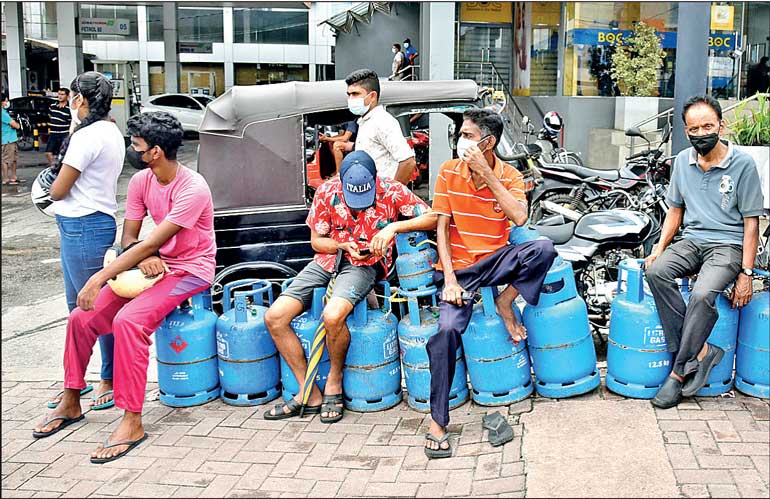Thursday Apr 24, 2025
Thursday Apr 24, 2025
Friday, 17 June 2022 00:10 - - {{hitsCtrl.values.hits}}

 As one of the world’s foremost international humanitarian organisations, the United Nations has pledged to provide food and medicines to cash-strapped Sri Lanka – a country suffering from a major financial crisis.
As one of the world’s foremost international humanitarian organisations, the United Nations has pledged to provide food and medicines to cash-strapped Sri Lanka – a country suffering from a major financial crisis.
As of last week, a UN team, led by the Resident Coordinator in Colombo, Hanaa Singer-Hamdy has appealed to international donors for more than $ 47 million in “life-saving assistance” to 1.7 million people in a country with a population of over 22 million.
This stands in contrast to the staggering $ 5.0 billion the Government is seeking for the island’s economic survival during the next six months—primarily for food, fuel and fertiliser.
Last month, the UN announced that with a $ 1.5 million donation from the Government of Japan, the UN’s children’s agency UNICEF will procure medicines for over 1.2 million people, among them 53,000 pregnant mothers and nearly 122,000 children with immediate medical needs.
The World Food Programme (WFP) is expected to receive about $ 1.5 million from Japan to provide food assistance to children and families in need of support.
In addition, Australia has made available the equivalent of nearly $ 5 million for food security, essential medicines for women’s health, nutrition data collection and analysis with UN agencies working together, including the Food and Agriculture Organization (FAO), the World Food Programme, the World Health Organization (WHO), the UN Population Fund (UNFPA) and the UN Children’s Fund.
Currently, some of the UN’s biggest aid recipients are either countries embroiled in military conflicts such as Ukraine, Afghanistan and Yemen – or the 46 member states categorised as Least Developed Countries (LDCs), “the poorest of the world’s poor”.
The majority of LDCs are from Africa, including Angola, Rwanda, Zambia, Burkina Faso, Ethiopia, Somalia and the Central African Republic, while the LDCs from Asia include Nepal, Bhutan, Bangladesh, Myanmar and Afghanistan.
According to published reports, Sri Lanka’s foreign exchange reserves have hit a low of $ 1.9 billion, equivalent to funds that could finance less than one month’s imports while its debt service repayments amount to about $ 6.9 billion. Last month, Sri Lanka defaulted on its debt repayments for the first time in history.
An editorial in the Sri Lanka Sunday Times put the problem in its right perspective: “Once called the ‘Granary of the East’, Sri Lanka is also considering tapping the SAARC Food Bank – from the buffer stocks of India, Pakistan and Bangladesh. The country is not only financially bankrupt, it is facing a famine in a few months”.
“From a middle-income country not long ago, it has come to this,” said the editorial.
“What an inglorious comedown for the country and humiliating stigma for its people no better personified by the presence of its Foreign Minister and chairman of the ruling party accepting a container of food aid from abroad at the Colombo harbour.”
“Brought about by stupendously irresponsible agricultural policy decision-making at the highest levels of Government, it is now humble-pie that is left to be eaten as Sri Lanka appeals to the world for food in the midst of a global economy facing recession, inflation, and a hurricane of shortages of oil, gas and wheat.”
Should Sri Lanka, long designated by the UN as a “middle-income country,” be heading towards the ranks of the 46 LDCs?
In an interview with IPS, Ambassador Anwarul K. Chowdhury, former Permanent Representative of Bangladesh and the first Under-Secretary-General and UN High Representative for LDCs, Landlocked Developing Countries and Small Island Developing States, responded to questions on the benefits and privileges of being an LDC.
“LDCs benefit from exclusive international support measures (ISMs) in the areas of trade, development cooperation and participation in international organisations and processes.”
Such measures in the area of trade, he pointed out, include preferential market access for goods and services; special treatment under World Trade Organization rules and certain regional trade agreements; and technical assistance and capacity building.
A range of financial and technical assistance provided by multilateral and bilateral partners, such as special programmes and budget allocations at the UN, including the Technology Bank for LDCs and Fund for LDCs, established by the United Nations Framework Convention on Climate Change (UNFCCC). Support for debt cancellation and/or debt rescheduling are also available for LDCs, he added.
Other support measures help LDCs participate in international forums, such as caps and discounts on contributions to the budget of the United Nations and financial support for representatives of LDCs to travel to General Assembly and other meetings, said Ambassador Chowdhury, who was also Senior Special Adviser to UN General Assembly President (2011-2012).
Excerpts from the interview:
Q: Do you think that Sri Lanka, which has appealed for humanitarian assistance from the UN, may end up being an international basket case?
It is not conceivable that Sri Lanka would become an international basket case. But it needs to steer away from the man-made, to say more directly, the current corruption-driven economy, in the right direction to return to its steady developing socio-economic development of yester years.
Among the eight members of SAARC only three are not LDCs, but among the other five LDCs, the Maldives have already “graduated” out of the LDC category and Bhutan, Nepal and Bangladesh are scheduled to graduate by 2026 (as their economies improve).
Being the victim of a catastrophic economic mismanagement should not prompt Sri Lanka to think of seeking an LDC status. The United Nations defines LDCs as countries that have low levels of income and face severe structural impediments to sustainable development.
Q: If the situation continues to deteriorate, what are our chances of joining the 46 LDCs?
Joining the LDCs group involves a long process and requires fulfilment of all three criteria to be eligible. According to the UN, those three are:
1. Income: Countries must have an average per capita income (GNI) of below $ 1,018 for inclusion, and above $ 1,222 for graduation.
[The Gross Domestic Product per capita in Sri Lanka was last recorded at 4052.75 US dollars in 2020.]
2. Human Assets: Countries must also have a low score on the Human Assets Index (HAI), a tool that measures health and education outcomes, including under-five mortality rate, maternal mortality, adult literacy rate and gender parity for secondary school enrolment. [Sri Lanka is much above the “60 or below” threshold.]
3. Economic and Environmental Vulnerability: Countries must score high on the Economic and Environmental Vulnerability Index (EVI), which measures factors like remoteness, dependence on agriculture and vulnerability to natural disasters.
[Sri Lanka is below “36 or above” threshold. The current economic downturn and challenges faced by Sri Lanka may not fully fit the country’s EVI threshold]
Q: How does this work? Does Sri Lanka have to apply to the UN for LDC status?
The Committee for Development Policy (CDP) reviews the list of LDCs and makes recommendations for inclusion in and graduation from the category every three years.
According to UN guidelines, the time frame of the eligibility procedure includes preliminary finding that the country satisfies inclusion criteria; notifies the country of its findings; prepares a country assessment note; provides a draft to the country; finds the country eligible and formally notifies the country of eligibility conclusion; and the General Assembly finally takes note of the CDP recommendation.
Q: What’s the downside of being an LDC?
In reality, there is no downside except the psychological perception of being categorised as one of the poorest countries. Some say that foreign direct investment (FDI) is not forthcoming.
If there is a downside, how come six countries have “graduated” from LDCs over the years since the category was established by the General Assembly in 1971 and ten more are in the pipeline for graduation by 2026.
(Source: https://www.ipsnews.net/2022/06/sri-lanka-join-ranks-poorest-worlds-poor/)
Discover Kapruka, the leading online shopping platform in Sri Lanka, where you can conveniently send Gifts and Flowers to your loved ones for any event including Valentine ’s Day. Explore a wide range of popular Shopping Categories on Kapruka, including Toys, Groceries, Electronics, Birthday Cakes, Fruits, Chocolates, Flower Bouquets, Clothing, Watches, Lingerie, Gift Sets and Jewellery. Also if you’re interested in selling with Kapruka, Partner Central by Kapruka is the best solution to start with. Moreover, through Kapruka Global Shop, you can also enjoy the convenience of purchasing products from renowned platforms like Amazon and eBay and have them delivered to Sri Lanka.
Discover Kapruka, the leading online shopping platform in Sri Lanka, where you can conveniently send Gifts and Flowers to your loved ones for any event including Valentine ’s Day. Explore a wide range of popular Shopping Categories on Kapruka, including Toys, Groceries, Electronics, Birthday Cakes, Fruits, Chocolates, Flower Bouquets, Clothing, Watches, Lingerie, Gift Sets and Jewellery. Also if you’re interested in selling with Kapruka, Partner Central by Kapruka is the best solution to start with. Moreover, through Kapruka Global Shop, you can also enjoy the convenience of purchasing products from renowned platforms like Amazon and eBay and have them delivered to Sri Lanka.